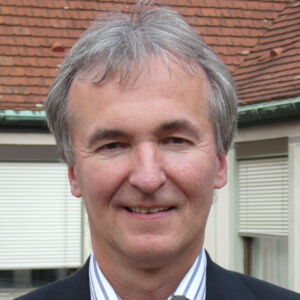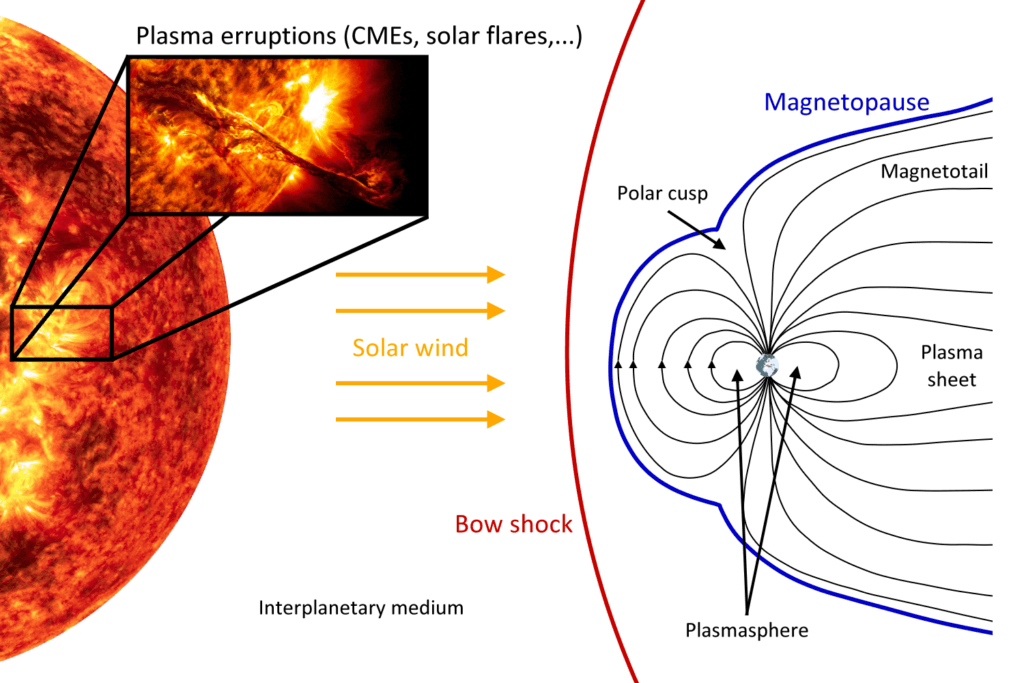GGOS Focus Area
Geodetic Space Weather Research – GSWR
Introduction
Space weather means today an independent, very up-to-date and interdisciplinary field of research. It describes physical processes in space mainly caused by the Sun’s radiation of energy. The manifestations of space weather are multiple, for instance,
- variations of the Earth’s magnetic field,
- polar lights in the northern and southern hemisphere,
- variations of the upper atmosphere with the compartments magnetosphere, ionosphere and thermosphere (MIT system) (due to coupling processes),
- solar wind, i.e. the permanent emission of electrons and photons,
- interplanetary magnetic field,
- electric currents.
The interplanetary magnetic field (IMF) is the component of the solar magnetic field that is dragged out from the solar corona by the solar wind flow (see Fig. 1).

Michael Schmidt
E. Forootan
Vice-Chair of FA GSWR
(Denmark)
Figure 1: Scheme for the interaction of the Sun as ionization source and the Earth’s magnetic field, inspired by ESA; for details see Limberger (PhD thesis, TUM, 2015)
The most extreme known space weather event happened on September 1, 1859 – the Carrington storm: a solar coronal mass ejection (CME) hit the Earth’s magnetosphere and induced the largest registered geomagnetic storm. Other prominent recent, but much weaker events have been the Halloween storm on October 28 – 30, 2003, or the St. Patrick’s storm on March 17, 2015. In early February 2022, the poor understanding of thermospheric neutral density changes, caused by unexpected magnetic storms, resulted in the accidental re-entry of 38 Starlink satellites with the cost of more than 10 million EUR. More than 900,000 small debris objects with a radius of at least 1 cm are currently orbiting uncontrolled in the upper atmosphere, which are potential treats to operational satellites. The strength of these events, their impacts on modern society and the possibility of much stronger future events have brought several countries such as US, UK, Japan, Canada, and China to recognize the necessity of studying these impacts scientifically, of developing protection strategies and procedures and to establish space weather data centers and space weather services. Because of these activities the FA-GSWR was initiated.
For a long time, geodesists looked at the ionosphere just as a disturbing factor, whose impacts on electromagnetic signal propagation, i.e. the signal delay and the bending of the ray path, have to be corrected by applying ionospheric correction models of sufficient accuracy. On the other hand, as already mentioned before, the observation data of various geodetic measurement techniques that are influenced by the atmosphere in different ways provide valuable information on state and dynamics of the ionosphere. These are of great interest also for other disciplines such as meteorology.
The following statements summarize the necessity of geodesy to cover scientific research on the coupled processes within the magnetosphere, ionosphere/plasmasphere, and thermosphere (MIT): Geodesy has
- to deal with the ionosphere and plasmasphere, since the measurements of almost all space-geodetic observation techniques are depending on the charging state of the upper atmosphere, i.e. the ionosphere and plasmasphere,
- to deal with the thermosphere, since the thermospheric drag is the most important deceleration effect on Low-Earth Orbiting (LEO) satellites and objects in the re-entry stage,
- to deal with the magnetosphere as it comprises the ionosphere, plasmasphere and thermosphere,
- a long history and large experience in the development and application of sophisticated analysis techniques and modelling approaches.
Today, for Geodetic Space Weather Research geodesy has to go another step forward by introducing physics. To be more specific, we must consider the complete chain of cause and effect. This means the research has to start with processes and events on the Sun. Next, it has to continue with the effects in the near-Earth space and finally it has to consider the impact on (geodetic) applications and systems. Besides this general chain of cause-and-effect interactions, physics and especially the coupled processes within the MIT system have to be regarded. Geodetic Space Weather Research is fundamental research, too, particularly when intending to detect and to survey structures of the ionosphere, e.g. bubbles, or when studying special phenomena like electro-jets. Summarizing, geodetic space weather research has to be based on
- the use and combination of all space geodetic observation methods,
- the use of Sun observations,
- real-time modelling,
- the development of deterministic and stochastic forecast approaches including Machine Learning (ML) algorithms,
- assimilation strategies.



